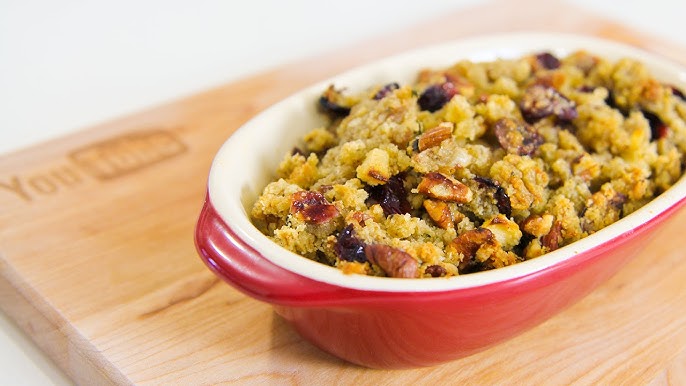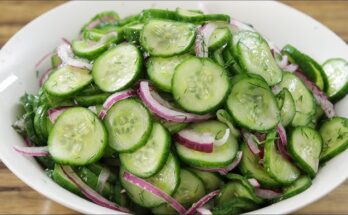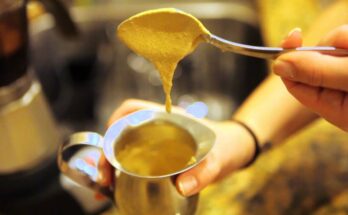Stuffing Recipe: Stuffing is more than just a side dish—it’s a holiday staple that brings warmth and flavor to the table. Whether it’s Thanksgiving, Christmas, or a Sunday roast, stuffing plays a key role in complementing the main dish with its savory, aromatic goodness. From classic bread-based recipes to unique spins like sausage or wild rice stuffing, there’s a version for every taste. This guide will walk you through every step, so you can create a delicious stuffing that will leave your guests wanting seconds.
Ingredients You’ll Need
Before you begin, gather your ingredients to make sure everything runs smoothly. Here’s a list of the essentials:
Main Ingredients:
- 10 cups bread cubes (French bread, sourdough, or baguette)
- 1 cup unsalted butter
- 2 onions, finely chopped
- 3-4 stalks celery, diced
- 3 garlic cloves, minced
- 2-3 cups chicken or vegetable broth
- 2 eggs, beaten (for binding)
- Fresh herbs: sage, thyme, parsley (about 2 tbsp each)
- Salt and pepper to taste
Optional Add-ins for Customization:
- 1 pound sausage (for a meatier stuffing)
- ½ cup dried cranberries or raisins
- ½ cup chopped nuts (pecans or walnuts)
- Mushrooms, apples, or chestnuts
Tools and Equipment Required
- Large mixing bowl
- Baking dish (9×13 inches)
- Skillet for sautéing vegetables
- Whisk for mixing eggs and broth
- Aluminum foil (for baking)
Types of Stuffing
Not all stuffing recipes are created equal! Depending on your preferences, you might want to explore different types:
- Bread-based stuffing: The most traditional variety, using stale or toasted bread cubes.
- Cornbread stuffing: Great for Southern-style meals.
- Meat or sausage stuffing: Adds depth with rich, savory flavors.
- Wild rice stuffing: A gluten-free alternative with earthy flavors.
How to Prep the Ingredients
Start by preparing your bread cubes. If your bread isn’t stale, you can dry it in the oven. While the bread toasts, dice your onions, celery, and garlic. If you’re adding sausage, cook it in a skillet until browned.
Step-by-Step Instructions for Making Stuffing
Step 1: Toasting or Drying the Bread
For stuffing that holds up without becoming mushy, your bread needs to be dry.
- Oven Method: Spread bread cubes on a baking sheet and bake at 250°F (120°C) for 20-30 minutes until lightly toasted.
- Overnight Method: Leave the bread cubes out on the counter overnight to dry naturally.
Step 2: Cooking Aromatics and Herbs
Heat butter in a large skillet over medium heat. Add onions, celery, and garlic, and sauté until soft and fragrant (about 5-7 minutes). Toss in fresh herbs like sage, thyme, and parsley, stirring for another minute to release their aroma.
Step 3: Adding Broth or Stock
Slowly pour in chicken or vegetable broth while stirring. The goal is to moisten the bread cubes without making them soggy. Use 2 to 3 cups, depending on how much liquid your bread absorbs. Whisk in beaten eggs to help bind the mixture.
Step 4: Combining the Ingredients
In a large mixing bowl, combine the bread cubes with the sautéed vegetables and herbs. If using sausage or any other add-ins, fold them in now. Make sure everything is evenly mixed.
Step 5: Seasoning the Stuffing
Season with salt and pepper to taste. If you’re feeling adventurous, toss in some dried cranberries for a touch of sweetness or chopped nuts for added texture.
Step 6: Baking the Stuffing
Preheat your oven to 350°F (175°C). Grease your baking dish and transfer the stuffing mixture into it. Cover with foil and bake for 30 minutes. Then, remove the foil and bake for another 15-20 minutes to get a crispy, golden top.
How to Know When Stuffing Is Done
The stuffing should be golden brown on top and moist but not soggy inside. If you’ve used eggs, ensure the internal temperature reaches 165°F (74°C) for food safety.
Tips for Perfect Stuffing Every Time
- Too dry? Add a bit more broth during baking.
- Too soggy? Bake uncovered for longer to evaporate excess moisture.
- Let it rest: Allow the stuffing to sit for 10-15 minutes after baking to set the flavors.
Creative Variations and Add-ins
- Vegetarian: Skip the sausage and use vegetable broth.
- Sausage and apple stuffing: Brown sausage with diced apples for a sweet and savory twist.
- Gluten-free: Use gluten-free bread or wild rice instead of traditional bread cubes.
FAQs about Stuffing Recipe
1. What ingredients do I need for a basic stuffing recipe?
A basic stuffing recipe typically requires bread cubes, butter, onions, celery, poultry seasoning, salt, pepper, and broth. You can also add extras like sausage, nuts, or dried fruits to enhance the flavor.
2. Can stuffing be made vegetarian?
Absolutely! To make vegetarian stuffing, substitute vegetable broth for chicken or turkey broth and omit any meat. You can add more vegetables, nuts, or even vegan sausage for added texture and flavor.
3. How do I keep my stuffing from getting too dry?
To prevent dry stuffing, ensure you add enough broth to moisten the bread. The stuffing should be moist but not soggy before baking. Covering the dish with aluminum foil during the first part of baking can also help retain moisture.
4. Can stuffing be prepared ahead of time?
Yes, you can prepare stuffing one day in advance. Keep the wet and dry ingredients separate and combine just before baking. This helps keep the texture and flavor of the stuffing at its best.
5. What is the best way to bake stuffing?
Stuffing is best baked in a covered casserole dish at 350°F (175°C) for about 30 minutes, then uncovered for another 10 to 15 minutes to allow the top to crisp up. If you like a moister stuffing, keep it covered throughout the baking process.
6. How do I know when the stuffing is done?
Stuffing is done when it’s heated through and the top is golden and crisp. The internal temperature should reach 165°F (74°C) to ensure it’s safe to eat, especially if it includes eggs or meat.
7. Can I cook stuffing inside the turkey?
While traditional, cooking stuffing inside a turkey can be risky as it must reach a safe temperature of 165°F (74°C). For safety and even cooking, it’s recommended to bake stuffing separately.
Conclusion
Making stuffing from scratch is easier than you might think, and it’s a great way to impress your guests. With a few simple steps—like toasting the bread, cooking aromatics, and baking to golden perfection—you’ll have a dish that’s bursting with flavor. Whether you stick to the classic recipe or add your own creative spin, this stuffing will become a cherished part of your holiday traditions.
References
To ensure the reliability and depth of our stuffing recipe, we’ve utilized several esteemed sources that can offer additional insights and validate the cooking methods discussed. For readers interested in exploring more about stuffing recipes and cooking techniques, the following references are highly recommended:
- Epicurious – Provides a comprehensive guide on various stuffing recipes, including tips on how to customize your stuffing with different herbs and spices. Explore Epicurious’s Stuffing Recipes.
- Allrecipes – Features user-rated and reviewed stuffing recipes that cater to a wide range of tastes and dietary needs, complete with step-by-step cooking instructions. Visit Allrecipes for More on Stuffing.
- Food Network – Offers professional insights from top chefs on making the perfect stuffing, including videos and detailed articles. Learn from Food Network’s Expert Chefs.
These sources are excellent for both novice cooks and seasoned chefs looking to enhance their culinary skills and understanding of making perfect stuffing.
For further reading and exploration of diverse stuffing variations, including gluten-free and vegan options, these websites serve as invaluable resources. By referencing authoritative culinary sites, we ensure our content is accurate and trustworthy, enhancing your cooking experience with every dish.



